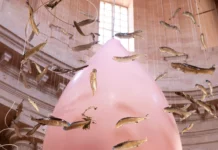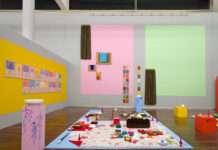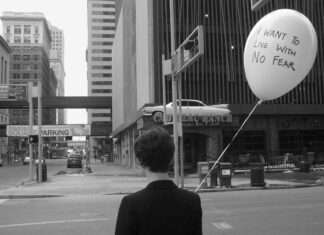Exhibition View « Through a Feminist Lens » 2020, EIB art collection, Luxembourg
The EIB’s art collection consists of over 1000 artworks (paintings, photographs, works on paper, sculptures and installations), from European and Europe-based artists. The development of the collection remains a continuous process of renewal, reflecting changes in the EU and its art, more and more focusing on emerging artists.
The collecting policy requires works of art to have been produced after 1958, by an artist alive at the time of acquisition who comes from one of the EU Member States or candidate countries. Art acquisitions are subject to a rigorous process of selection, under the guidance of an Arts Committee and with the assistance of well-established experts. Delphine Munro, Head of Arts & Culture is dedicated to the promotion of the collection through exhibitions, conferences, symposiums.. along with other art & culture initiatives such as pairings, clusters and curatorial threads. She also created in 2013 the Artists Development Programme (ADP), a residency and mentorship programme for European visual artists under the age of 35. I meet her during the Open Studio of the 2022 selection of artists at Cité des Arts (Paris), under the mentorship of franco-italian artist Tatiana Trouvé. She is chairman of the Board of IACCCA, International Association of Corporate Collections of Contemporary Art, a non-profit organisation made up of over 50 corporate collections from across the globe. Her vision and commitment to creation challenging european political social issues such as climate, gender, the refugee crisis, eco-feminism and post colonialism are worth listening to. She has also an immediate capacity of human interaction and dialogue, skills that are very usefull for her missions.
Delphine Munro is Head of Arts & Culture at the EIB Institute, managing all Arts & Culture activities for the EIB Group.This includes the management and enhancement of the EIB art collection, the development of a mentoring scheme for budding artists, the formulation of EIB Group employee engagement programmes. She joined the EIB Group in 2005, first as Head of Marketing Communications at the European Investment Fund, then as Head of Arts & Culture at the EIB in 2009.
She is also President of the Board of the Casino Luxembourg – Forum d’Art Contemporain; Board Member and Secretary of IACCCA (International Association of Corporate Collections of Contemporary Art) and also Board Member of Les Amis des Musées Luxembourg. She was a nominator for the 2013 Edward Steichen Award, and a jury member for the 2014 Prix Sciences Po pour l’Art Contemporain.
Delphine Munro has a twofold education, in Economics and Finance (Institut d’Etudes Politiques de Paris – Sciences Po) and in art history (post graduate, Courtauld Institute, London).
Prior to joining the EIB Group, she had 20 years’ experience in arts management and marketing communications: for museums (Musée National d’Art Moderne-Centre Pompidou, Paris), cultural institutions (Fondation Cartier, Paris; Institut Français, Prague), an auction house (Sotheby’s, London) and the corporate world (BNP Paribas and HSBC, both in London).
She was nominated Chevalier des Arts et des Lettres in 2018.
You are Head of Arts & Culture for the EIB Institute: what is your mission?
Arts & Culture is one of the pillars of the EIB Institute, part of the European Investment Bank, the lending arm of the European Union.
The EIB art collection and the Arts & Culture programme stand out for their dedication to European and Europe-based artists. My mission is to foster and accelerate this commitment. Along with the Arts & Culture team, we organise artists’ residencies, international exhibitions, internal exhibitions, loans, new acquisitions, publications, cultural engagement initiatives and more.
On a personal note, running the EIB’s Artists Development Programme (ADP) is one of my favourite parts of the job. Meeting young talent is absolutely invigorating. It also gives me a great sense of hope, as I am noticing a move towards environmental consciousness amongst even the youngest artists – for example Niamh Schmidtke, who worked on an artistic project centred around climate finance at the age of just 21.
The ADP offers European visual artists (under the age of 35) a residency in Luxembourg, mentored by an internationally renowned artist with a passion for transmission. Mentors have included Mirosław Bałka, Callum Innes, Darren Almond, Jorma Puranen and Tatiana Trouvé. Emerging artists develop their practice in a professional context without any material constraints, all under expert guidance. In the decade that the programme has run, the ADP has become a unique talent accelerator that prides itself on unfurling the potential of young artists.
In everything we do, our aim is to promote European and Europe-based artists, fostering a culture of art appreciation on the continent. Art tackles difficult topics fearlessly, creating space for people to understand each other on a deeper level. The nourishment of this unique sense of connection, a sense of connection that only art can offer, is a mission that I hold dear.
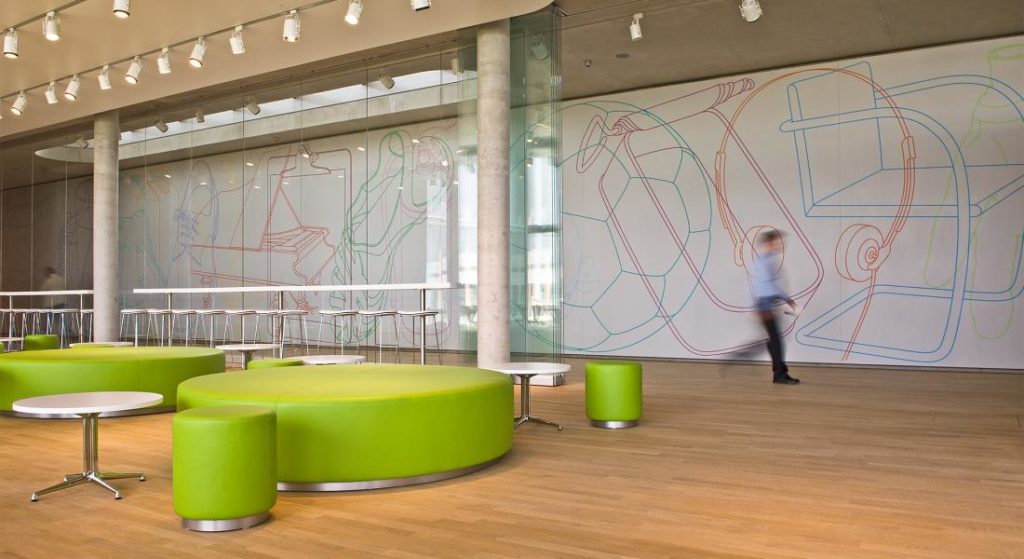
What are the main challenges of the EIB art collection?
The EIB art collection is challenging because of its remit, that of offering a panorama of European artistic creation. It is over 1000 artworks strong. What is now known as the “historical collection”, purchased by former Management Committee members after the establishment of the EIB in 1958, comprises a selection of Old Masters, 19th century and modern artworks. These historical artworks provide a glimpse into the rich canon of European art history, which many contemporary artists either reference or reject in their work. In the 1990s, the Arts Committee was put in place as a governing body, responsible for the acquisition of artworks following rigorous guidelines. The innovative decision was taken to focus solely on contemporary European art, giving priority to emerging or newly established artists. Works of art must have been produced after 1958 (the date of the Treaty of Rome and the foundation of the EIB); the artist must be alive at the time of acquisition; and they have to come from one of the EU Member States. Endless possibilities are presented by such a rich selection of artworks being brought together in dialogue. Through our many arts & culture initiatives, we strive to activate the collection. We create pairings, clusters and curatorial threads that ask challenging questions about European identity and turn the collection into a living communication tool as well as a vehicle for cultural diplomacy.
One of the greatest strengths of the EIB art collection is that it is not static. Commissions and new acquisitions are integral to our work. This is, of course, one of the most exciting and rewarding challenges. Every effort is made to ensure that the development of the collection reflects the evolving scope of the Europe (and therefore that of the EIB), particularly its geographic expansion. The collection thus reflects both the EIB’s evolving remit and changes in the EU. For example, the EIB art collection pays particular attention to new entrants to the Union, boasting works by many Eastern European artists. To mark the start of EIB lending in Central and Eastern Europe in the late 1990s, the EIB commissioned two works of art: by Tamás Trombitás (Hungary) – Letters, 1999 – and Magdalena Jetelová (Czech Republic) – Chair, 2000.
Looking ahead at the development of the collection, we are on a path to bring Europe’s multifaceted and dynamic identity to the fore. Since its inception, the Arts Committee has consciously and deliberately prioritised artists underrepresented in the art world, gathering acquisitions from Eastern Europe (in line with the EU enlargement), women artists and emerging talent. Now, we are expanding our engagement to include artists under-represented in the art market and the EIB art collection generally. Our recent acquisitions are from artists tackling social (in)justice, climate, gender, the refugee crisis, eco-feminism and post colonialism. The result has been overwhelmingly positive, bringing some of the art world’s most exciting contemporary artists, such as Taysir Batniji or Kiluanji Kia Henda, into the heart of the collection.
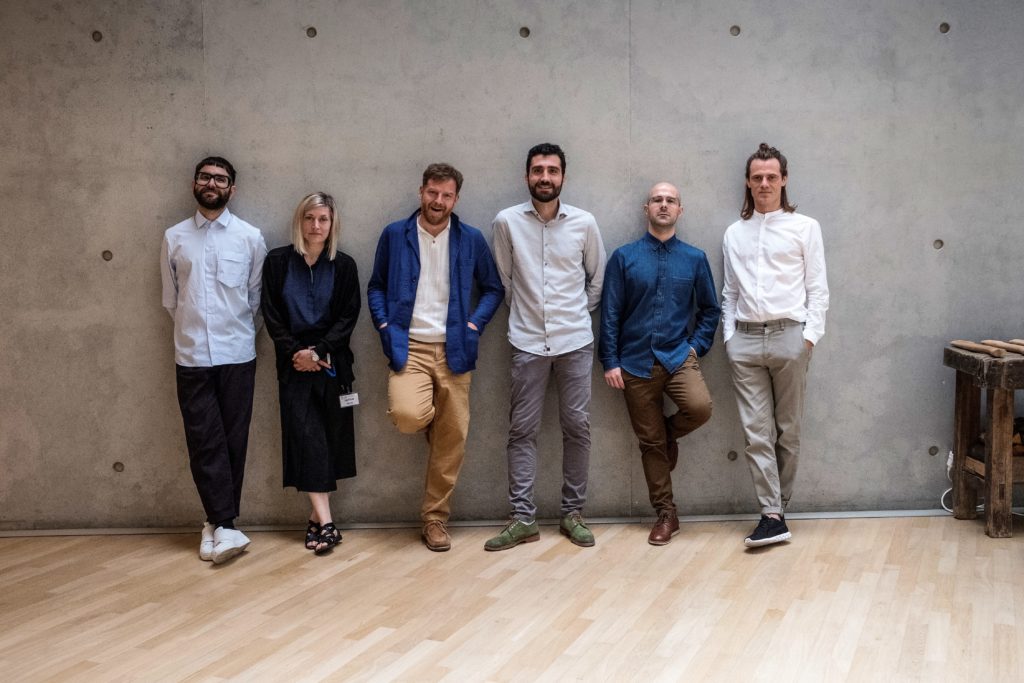
To mark the tenth anniversary of the ADP in 2022, the residency takes place at Cité internationale des arts in Paris under the mentorship of Tatiana Trouvé. How many artists applied to the call “The Imprint of Man – Representing the Anthropocene”? What made the difference between them?
To provide some context, I created the Artists Development Programme (ADP) in 2013 after noticing a critical shortage of development opportunities for young European artists freshly emerging from art school. The residency is divided into different “calls”: thematic and geographic. In 2022, we received 243 applications, 100 of which were for the thematic call, “Disruption: The Imprint of Man”. Originally called “Anthropocene – The Imprint of Man” (2014-2017), “Disruption” broadened the focus beyond the environment to include social as well as ecological disruption. This has been the most popular thematic call of the ADP since the programme’s inception. I believe this is because of the poetic possibilities offered by the Anthropocene. “Anthropocene” is the scientific term used to address the current geological age. In contrast to previous geological ages, the defining feature of the Anthropocene is human dominance over the environment. Artists are visual creatures, and so they are shaken by the fact that humankind is visibly marking the geological history of the Earth. Art can and must play an important role in stimulating an emotional responseto climate change, allowing people to connect with the crisis without being paralysed by the numbers.

Diplômée avec les
With this in mind, what makes an artist stand out amongst the many applications that we receive for “Disruption: The Imprint of Man”? The call certainly attracts socially-engaged artists, such as Jošt Franko (2021), who lived with and photographed migrants on the Balkan route; or Cooking Sections (2016) (whose practice focuses on food security, production and consumption) who interrogated the environmental and social consequences of “sun-seeking” retirees in the Caribbean. The latter were recently nominated for the Turner Prize in 2021. Despite these socially-engaged examples, our understanding of “Disruption” is very broad. The most recent artist to have been selected for this call, Pauline-Rose Dumas (2022), makes poetic amalgamations of metal and fabric, taking a more abstract approach. As with all of our calls, the title is a prompt, designed to give the artist an impulse. So, what we are really looking for is flexible and open artistic minds; artists who can take a spark and ignite a sense of momentum.
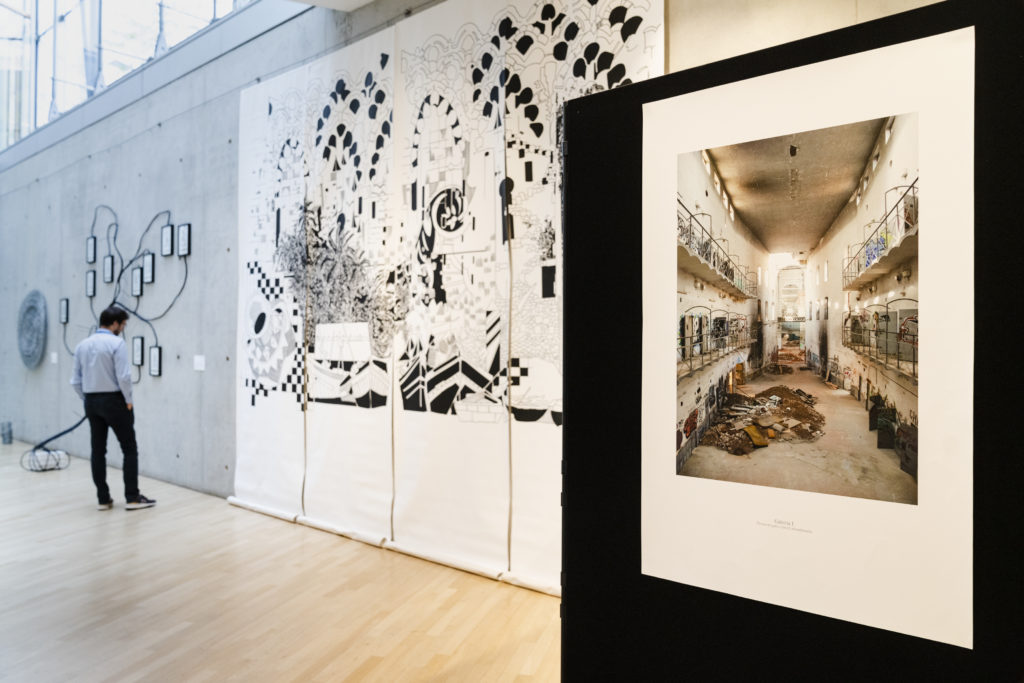
How did the exhibition « Through a feminist lens » reflect EIB commitment to feminist issues and social assumptions?
Through a Feminist Lens was an internal exhibition that opened at the EIB headquarters in Luxembourg on International Women’s Day in 2020. It was designed to showcase artworks in the EIB art collection that engaged with key feminist issues. One of these feminist issues was the climate emergency. The final section, ‘(Reviving) Ecofeminism’, revealed the historical connection between women’s rights and environmental rights. Ecofeminist art emerged in the 1970s as a means of rejecting man’s domination over both land and women. Women re-appropriated their stereotypical association with nature for both political and artistic ends. In line with the Climate Bank remit of the EIB, the EIB art collection boasts many artworks that actively explore environmental issues, ranging from the climate urgency to sustainable and balanced development.
Perhaps most interestingly, Through a Feminist Lens was not limited to women artists, but rather included male artists who had produced interesting works on the subject of gender. We have a particularly fascinating work by the Spanish artist Eduardo Arroyo that exaggerates and exposes the stereotypical gender roles taken on by men and women in a Spanish nightclub. More recently, we purchased an artwork by the emerging Portuguese artist Francisco Vidal titled Afro-Antoinette, which uses historical female icons to ask questions about the erasure of blackness from European history and post-colonial personhood.
Over the last few years, our new acquisitions have included extremely exciting women artists, who place forgotten female figures at the centre of their works: Patricia Kaersenhout, Mounira Al Sohl and Kapwani Kiwanga. It is thrilling that art can activate archives in this way and we will continue to shine a light on works that achieve this sort of illumination.
We also have actively sought to acquire artworks using textile – a medium too long associated with crafts and domesticity – which is finally recognised as a fully fledged art form and finally coming to the fore.
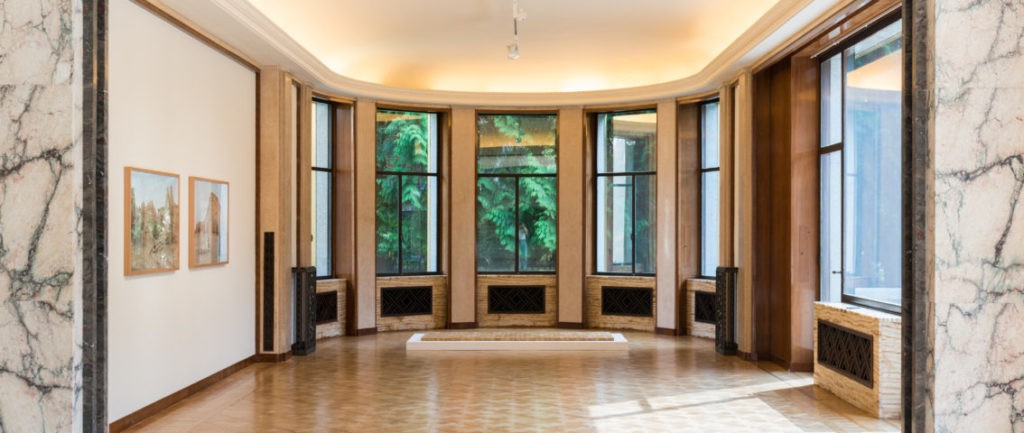
Which of your previous exhibitions were most successful?
This is a challenging question, because each of our exhibitions has fulfilled a very specific purpose. We use the art collection to emulate the EIB’s support for countries or regions at times of important economic challenges: the travelling exhibition Within/Beyond Borders, for example, was first showcased in Greece in 2011 and then Portugal in 2014, in response to the countries’ economic difficulties. As Greek and Portuguese arts institutions suffered significant cuts in their budgets, the EIB art collection stepped in to boost cultural development and underline the financial support of the EIB.
We also leverage the collection to celebrate key milestones: in 2015, EuroScope was curated at the request of the City of Luxembourg to celebrate Luxembourg’s presidency of the Council of the EU. Paying homage to the EIB’s host country, EuroScope strengthened cooperation with the Grand-Duchy in the field of cultural development.
And in 2018-19, the exhibition Beyond Borders –a collaboration between the Boghossian Foundation (Brussels) and the EIB art collection (to celebrate the EIB’s 60th anniversary) – brought together European, North African and Middle Eastern artists around the subject of identity, borders, exclusion, increased immigration and refugee flows. The exhibition aimed to encourage interaction between cultures and initiate a deeper “East-West dialogue”.
But, if I had to choose one exhibition, it would undoubtedly be our most recent exhibition, Belonging, which took place in Limerick, Ireland in 2022. It was special for many reasons. It was the largest ever exhibition of the EIB art collection to date, featuring over 80 works in 7 different locations. The participating institutions were all locally anchored: local museums, universities, a place of worship and cultural heritage sites. It was also the first exhibition to take place outside of a European capital city. Perhaps most importantly, I felt that the exhibition took on new resonance after the pandemic. It was originally designed to explore “the Europe we live in” at a time when Europe was seemingly fractured. But it was postponed for 2 years because of the sanitary situation. In the end, the themes that Belonging tackled – such as alienation, isolation, community, identity and sense of purpose – became all the more meaningful after what might be called the first truly globally shared experience in human history.
What is your definition of art ?
One of my personal favourite quotes is by the celebrated artist, Wassily Kandinsky: “Art is not vague production, transitory and isolated, but rather a power which must be directed to the improvement and refinement of the human soul.” He captures my feeling about art: that it is defined by an artist’s sense of purpose, as opposed to an aesthetic guideline.
This week I was particularly moved by the opening lines of Simon Schama’s most recent article in The Financial Times: “A poem cannot stop a tank. But the reverse is also true.” He was discussing the power of art in times of tyranny, referencing countries such as China, Iran and Ukraine. His words struck a chord with me because we recently took on our first Ukrainian ADP artist, breaking our usual strict EU nationality requirement in order to show support for Ukraine at this critical time. Nikolay Karabinovych is creating an incredibly moving video of his mother playing an imaginary organ after she was separated from her craft due to the invasion. The video is a visual poem, a silent poem. This is perhaps what art is: it is a coping mechanism; it is one of the few human impulses that thrives in both good and bad times, and therefore it must be protected and nourished. I hope that, through the EIB art collection and its ancillary art and culture programme, we can help artists thrive and flourish, ultimately creating a continent that is socially, intellectually and emotionally engaged.
More about :
The European Investment Bank Insitute
- The collection
- The Artistic Developement Program
Arts & Culture – EIB Institute
IACCCA : International Association of Corporate Collections of Contemporary Art



